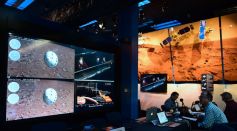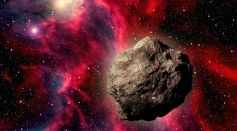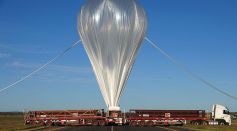Tags: NASA
NASA Threatened by China’s Possible Claiming of Moon Water; How Does Spacefaring Nations Agree with Territorial Access?
Boeing Pushes Back First-Ever Crewed Launch of Starliner Astronaut Capsule Indefinitely Over Safety Concerns

NASA's UAP Study Team Concludes More Data Needed to Explain Unidentified Objects in the Sky
NASA Will Have First Meeting About UAP After 9-Month Investigation
SpaceX Dragon Capsule Returns to Earth Safely, Ends Ax-2 Mission
NASA Lost Ingenuity Mars Helicopter for 6 Sols After Experiencing Total Communications Blackout

Closest Supernova Ever Observed Could Shine Bright For Months Even When Viewed From Amateur Telescopes

NASA Shares Stunning Cosmic Wonders Captured by James Webb Space Telescope and Chandra X-Ray Observatory
Academic Survey Reveals 1 in 5 Encounters Unidentified Anomalous Phenomena
Cataclysmic 21-Million-Year-Old Supernova the Closest Explosion of a Star Ever Observed

Japanese Moon Lander's Impact Site Found: NASA Lunar Orbiter Spotted Hakuto-R's Debris a Day After Its Failed Touchdown

SpaceX Launches Axiom's Second Private Astronaut Mission to the International Space Station
NASA's Massive Super Pressure Balloon Plummets Into the Pacific Ocean After Developing a Leak

NASA's Mars InSight Lander Determines Thick Crust and Radioactive Heat Source of the Red Planet

NASA Satellite Spots Early Signs of El Niño As Warm Waters Move Eastward Across the Pacific Ocean to West Coast

Massive Airplane-Sized Asteroid To Blaze Over Earth at Speed of 46,891 Mph

Huge Balloon Spotted Circling the Southern Hemisphere Sparks Fears That It's Being Used for Spying; What Is It Really?

James Webb Space Telescope Takes Its First Up-Close Look at the Mysterious Atmosphere of a Mini-Neptune Exoplanet

Solar Storm Early Warning System? AI, NASA Satellite Data May Provide 30-Minute Notice For Dangerous Space Events

On This Day 50 Years Ago: NASA Launched Historic Skylab Space Station on May 14, 1973
Most Popular

Starlink Satellite Explodes in Orbit; SpaceX Confirms It'll Re-Enter Earth

Aurora Phenomenon: How Geomagnetic Storms and Space Weather Are Lighting Up the World

Ocean Warming Explained: Why Climate Science Shows Sea Temperature Rise Is Speeding Up

How Wildfires Start, Spread, and Ignite: Understanding the Causes and Fire Behavior Clearly




